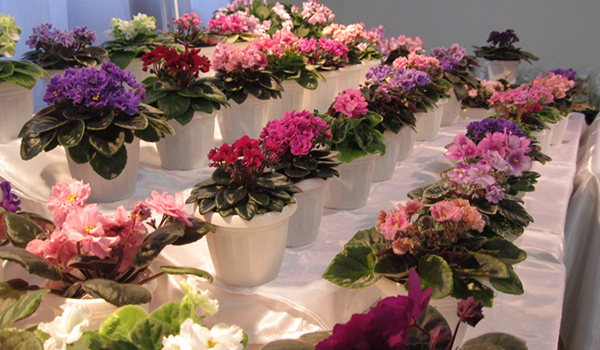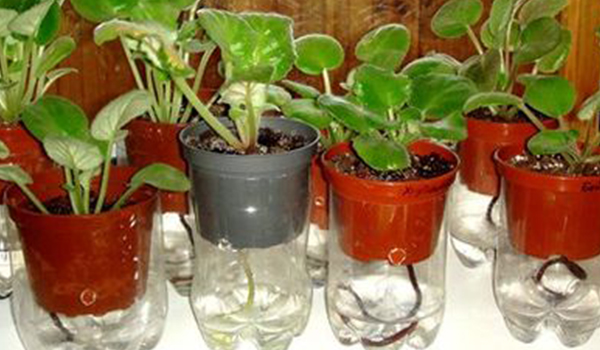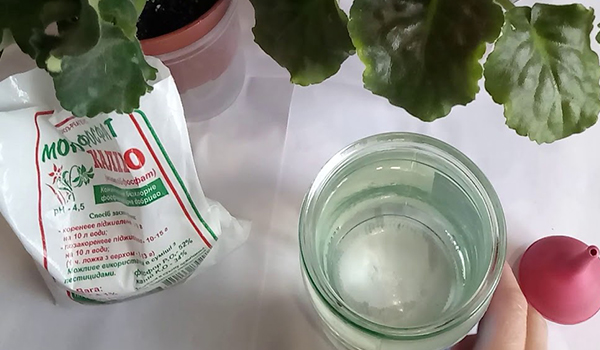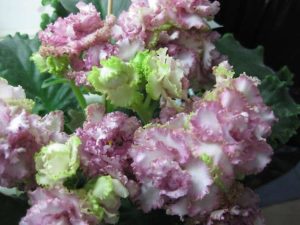Violets: care and cultivation at home
Although there are a lot of varieties of Saintpaulias, the care of all species is practically the same. And since this culture is considered quite whimsical, it is necessary to adhere to the rules of cultivation strictly.
This video tells you how to properly care for Saintpaulias at home.
Location and temperature
This miniflora grows well on all windowsills. For the hot season, the north side is better, and in the cold cloudy period, backlighting is necessary. On the south side, in the summer heat, plants may not survive.
Newspaper sheets, blinds and curtains made of dense light fabric (best of all natural) will become a real lifesaver. Leaves are severely burned in direct sunlight.
Advice! The extensive collection can be placed on shelves. The shelves can be of any length, but the width is from 30 to 35 cm. Thus, the pots can be arranged in two rows. When screwing on the shelves, keep in mind that a fluorescent lamp will be attached under each of them (at a distance of 15 to 25 cm to the leaves).
For normal growth and development, a comfortable temperature is + 18 - + 25˚C. The highest threshold is + 30˚C, the minimum is + 12˚C.

How to choose the soil?
In this matter, growers have almost complete carte blanche. The only taboo is fatty, heavy black soil. It is better to give preference to crumbly soil, which allows air and moisture to pass to the roots.
Saintpaulia collectors offer several options for soil mixes:
- 4 liters of peat with vermiculite + 1 tbsp. l. mineral fertilizer in dry form (5-10-10) + 1 tbsp. l. dolomite flour.
- Leafy + garden soil + sand with sphagnum moss (all components in one part).
- Peat + sod land (sod is cut in fields and meadows) + dung humus + sand and sphagnum moss (2: 1: 1/2: 1: 1). On a bucket of such a mixture, it is recommended to also put 1 liter of charcoal and 2 tbsp. l. dolomite flour and superphosphate.
Important! The violet will grow well in the usual purchased soil for Saintpaulias.
Watering and humidity

Experienced growers with many years of practice “feel” the plant. It is not so difficult to comprehend the basics of watering Saintpaulias. The plant consumes most of the moisture during the flowering period, in the warm season and with a very developed root system.
Air humidity and the composition of the earth also have a great influence. The lighter it is, the faster it dries. As a rule, they are guided by the state of the upper layer. Touch dry is warm and wet is cool.
Often this is done only through a pallet (water is poured into it and the pot is immersed for a while, and when the earthy lump is saturated, the flower is taken out and placed on a cloth). The wick method is also known.

When transplanting, a cord made of synthetic material is passed through the earthen lump, leading the lower end through the drainage hole of the container.
The first time is watered from above. All subsequent pot is placed on a vessel with water, an impromptu cord is dipped into it and wait for the violet to drink. This is the so-called capillary effect. Water must be taken standing and warm (+ 30 - 35 degrees).
On especially hot days, the air around the violets is moistened with a spray bottle or the leaves are washed with warm water (the liquid should not get on the flowers).
Top dressing and transplanting
Special fertilizers for Saintpaulias are on sale. They are brought in at the same time as watering every week.

With regards to transplanting, they do it only by transferring it into a plastic pot a couple of centimeters larger than the previous one. The procedure is carried out once a year after flowering (in spring). If the plant does not feel well in a pot or the soil is not picked up correctly, an emergency transplant is allowed.
Important! As for pruning, they do it only when necessary (if the leaves look drooping and unhealthy).
What can interfere with the proper growth of the bush
Healthy flowers look right.
Note! Appearance of the sensitive violet DS The shining bell instantly reflects ailments and disease processes. Diseases:
Diseases:
- withering lower leaves and the formation of a brown bush indicate a fatal late blight. It can be cured by watering with the addition of bravo, otherwise it is possible to save the top of the rosette and healthy leaves by rooting them in other pots with a preliminary treatment with 0.05% solution of the biosept drug or precursor according to the instructions. The soil affected by late blight is no longer suitable;
- brown leaves and flowers indicate gray rot. The flower should be set aside from others, the affected leaves should be removed and treated with euparen, rovral, kaptan or biosept twice a week;
- the leaves from below are covered with mucus and fall off with bacteriosis of the vessels of the bush, which often develops in hot rooms. You can cure a violet with the means of Previcur, Zircon, Fundazol and Immunocytophyte;
- the appearance of a white coating indicates powdery mildew; to treat it, benlate or fundozol should be injected once.
Parasites:
- small nematode worms parasitize on the root system of the violet, poisoning it with their vital activity. The leaves are covered with light green and later darkening and decaying spots. The growth of the violet slows down, flowering stops, after which it dies. It is impossible to cure a bush from nematodes;
- cobwebs and red dots on the leaves are a consequence of mite infestation. The cuttings are covered with brown trenches. Leaves turn yellow and fall off. The flower stops growing and does not bloom. In this case, the bush is treated with an acaricidal agent twice a week;
- aphids cover the bellflower with light secretions, parasitizing on the ground part of the plant, whose leaves lose their shape against the background of stopping growth. You can cure a violet with actellik or mospilan;
- if brown and drying leaves with moving dark dots are found, it is necessary to place insecticide tablets or capsules in the soil. These pests are small insects, thrips.
What can interfere with the normal growth and flowering of the shining bell
DS A shining bell can get fungus if temperatures are too cool or too much water. Late blight can also develop from the latter, which can be insured by placing superphosphate in the soil. Almost any representatives of the Arthropod order also carry a threat to violets.
Thus, there are many factors that must be considered in order for the Bellflower violet to bloom and develop. If you miss even one moment, it will quickly shed its buds and wither.
Description
For the first time, the violet was found in Africa, on the territory of eastern Tanzania in the Uzambara mountains by the French baron Saint-Paul. Therefore, the uzambara violet and saintpaulia are the names of the same flower. In some countries it is called African. On the basis of natural violets, various species have been bred, which are called hybrid saintpaulias. Of all the names of this plant, violet is more familiar to us.
Yellow violet is an indoor plant, perennial and evergreen. The stem is shortened, the leaves are covered with villi with a cordate base and a pointed or rounded top. A violet calyx consists of 5 petals and sepals. The fruit is a small box with seeds. The size of the Saintpaulia rosette ranges from 20 to 40 cm in diameter.
Natural violets have a small range of colors: bluish, blue, burgundy. There are no yellow violets in nature due to the lack of a gene responsible for this color.But if a violet has its signs: light yellow spots, rays or strokes on the petals, then it is already called yellow or yellow-flowered. The yellow pigment does not appear immediately in violets. Initially, the color appears light lemon, pale yellow or creamy. Only in adult plants does it become brighter.
Violet AN-Kopeechka (N. Andreeva)
Violet AN-Kopeechka.
Systematic position
The Uzambar violet of the AN-Kopeechka variety is classified by taxonomists in the genus Saintpaulia hybrid, the Gesnerievye family. This family also includes the genera of the famous pets Gloxinia and Streptocarpus.
Photo and description of the variety
The variety of Saintpaulia AN-Kopeechka blooms with simple watercolor-lilac annoys with a clear purple border and green ruffles. The violet has an original appearance. The contrasting color creates the effect of a convex flower.
The leaves are medium green, with a wavy fringed edge. The outlet is very large. The size of the leaves in relation to the flowers is impressive. The sheet is folded down, so a flat rosette does not work.
The sport of the AN-Kopeechka variety is no less interesting and very easy to grow.
This variety has sports.
There are also chimeric sports varieties.
Growing tips
In order to grow this beautiful variety at home, you should carefully study the following recommendations of experienced florists.
- Landing. Violet pots shouldn't be very large. Ideally, the recommended diameter of the pot is three times smaller than the rosette of the plant. Leafy cuttings and "babies" can be grown in small plastic cups, while adults should choose clay or plastic pots. When planting, you can use ready-made soil for Saintpaulias or make a mixture of leafy soil, turf, coniferous soil and peat in a ratio of 3: 2: 1: 1. Do not forget to add a baking powder to the soil: perlite, vermiculite or sphagnum moss. It is necessary to renew the earthen mixture in adult plants every two to three years.
- Lighting. The plant needs good lighting for at least 13-14 hours daily. In winter, this violet should be kept on the window near the glass and use additional lighting. In summer, it is imperative to shade from direct sunlight.
- Temperature. This variety likes warmth (20-22 degrees Celsius). But if the plant is not kept cool at the stage of bud formation, then the characteristic green lines on the flowers will not form.
- Air humidity. This flower loves moisture - it should be at least fifty percent. However, do not spray the violet with a spray bottle. It is better to place it on a pallet with moistened pebbles or put a container of water nearby. Once a month, you can arrange a hygienic shower, but after that, be sure to remove all the water that remains on the leaves.
- Watering. Despite the general unpretentiousness of this variety, the plant should be watered regularly with settled soft water at room (or slightly higher) temperature. It is also possible to irrigate through the sump and by the wick irrigation method. The main thing is to avoid getting water drops on the leaves and the outlet.
- This variety grows quickly, but it is necessary to feed the flower with special fertilizers during the period of active growth and at the stage of bud formation. In autumn and winter, plant feeding is not needed.
Planting and leaving
Violets are unpretentious in content. Having familiarized yourself with the rules for their reproduction, the requirements for the conditions, you can get a good result. Proper care will allow your plants to bloom for a long time, even twice a season.
Choosing a place for violets and soil composition
When deciding on a site for planting perennial pansies, choose a slightly acidic or neutral soil. They will also appreciate the fertile soil on an elevated site. Drainage in the form of sand or gravel is required - let excess water seep there.
Viols are also demanding of lighting: they love the sun and diffused lighting. The shade of the taller neighbors would be appropriate.
We sow in open ground
The viola seed material remains viable for 2 years. Then this ability is lost. Violet seeds can be planted directly in open ground during the summer or before winter.
The location is chosen as described above. Then the prepared material is planted in 1-2 cm depressions. The distance is chosen 5-10 centimeters, then they can be planted. The next year, you will receive blooming of quite large baskets.
Seedling method
A great way to get new varieties. Seeds are purchased in a specialized store, there is a wide selection of them. These are both simple and terry hybrid varieties.
Sowing is done in March in containers with a special soil for violets, or with another flower.
- We spread the seeds into the prepared boxes with the ground, deepening by 0.5-1 centimeters, sprinkle them;
- Water the planting and cover it on top with a film, glass;
- Place the seedling container on a light window sill and periodically ventilate, spray from a spray bottle;
- Seedlings will appear in a week or 10 days;
- Then we remove the film and leave it to grow in warm conditions;
- We are waiting for the seedlings to grow up, the number of leaves should be at least 4 - then they can be planted in permanent places.
Seedlings are planted at a distance of 20-30 centimeters, as soon as the threat of frost in May has passed.
Propagation by cuttings
Perennial varieties of violets can be propagated using cuttings. For this, a stem with two leaves is cut off, which is placed in water to obtain roots. The procedure is carried out in June or July, the roots appear in 15-20 days.
Reproduction by dividing the bush
There are varieties of violets with a spread rhizome, it is they who can be divided. Even before flowering or in autumn, the bush should be dug out, the stems and leaves should be removed, and divided into parts. Plant the plants in separate containers or open ground.
Watering and feeding
As already mentioned, viola reacts negatively to waterlogging of the soil. Water sparingly in dry weather; spraying is a good measure.
For rich flowering, plantings are periodically fed, 2-3 times during the growing season - the best option. Purchase any mineral composition for plants, treat your favorite flowers with it.
Pruning
When the heat sets in, the stems of the violets stretch upward, towering over the bush. If this is not to your liking, you can cut off outstanding peduncles, giving the bush compactness. Cut plants grow back very quickly. Dry baskets are removed to prolong flowering.
Diseases of violets
This flower is susceptible to various diseases. The main reasons are waterlogging of the soil, violation of lighting and overfeeding with fertilizers.
The violet can be affected by fungus, powdery mildew, leaf spot, and the appearance of black dots. Treatment with chemicals helps with many diseases. If the infection is already strong, then the bush should be dug up and destroyed.
If the stalk is thinned and darkened, it is a black leg. It occurs when crops are thickened or moisture is high. When water stagnates, slugs attack the plant.
In summer, pansies are an excellent target for clover moth and violet mother-of-pearl. Spray the plant with tobacco infusion or insecticides to get rid of parasitic insects.
How to grow?
Container selection
Experts recommend choosing a small pot for the plant. Too much capacity will negatively affect the development of the plant, and all its strength will go to the growth of the root system. In addition, the violet will not take up much space. For young flowers, pots with a diameter of no more than 5-6 cm are great. Older plants are chosen in more spacious containers: from 7 to 9 cm. For large violets, pots up to 13 cm are purchased.
The soil
The best soil for home violets is a ready-made, balanced earthy mixture that is sold in almost any specialty store.The composition is saturated with all useful microelements necessary for the full development and lush flowering of violets. There are no parasites and pests in a quality product, so the soil does not need to be further processed before use.
If you wish, you can make a suitable mixture at home. To do this, mix sod and leafy soil with humus and sand in the proportion of 0.5X2X1X1. Add half a glass of bone meal and a spoonful of superphosphate to the composition. All components should be thoroughly mixed to distribute them evenly. Correctly selected soil for a plant perfectly absorbs moisture, is loose and remarkably breathable.
Temperature conditions
Ideal temperatures for the Sea Wolf range from +20 to + 24 ° С. Young plants feel great in hotter conditions, in contrast to adults, for which a temperature of 20 ° is considered ideal. With the onset of winter cold weather, the plant will have enough 16 ° warm. Drafts should be avoided at any time of the year.
Light
A flowering plant loves natural light. The best place to place it is a windowsill on the east or northwest side. You can also put a flower pot on the south side, but be careful not to get direct sunlight on the violet. During the short daylight period, artificial light sources are indispensable. The violet needs 13-14 hours of lighting.
Reproduction
There are several ways to propagate a plant:
- seeds (the most difficult option, therefore it is used very rarely);
- children;
- leafy cuttings;
- vegetative methods.
The second method of reproduction is used when the plant becomes cramped due to the formation of a large number of children. In this case, the flower should be carefully removed from the container so as not to damage the root system, to separate the roots of the rosettes from the mother plant and plant them in pots. The process of transplanting violets is tolerated without problems even during the period of active flowering.
Plant diseases and pests
Violet is affected by diseases if the recommendations for the content are violated and the rules for caring for the plant are not followed.
Most often, violets suffer from the following diseases:

If the leaves of the violet begin to turn yellow, it should be treated with a fungicide.
Powdery mildew. Signs of the disease are whitish spots on the leaves. For treatment, Fundazole is used.
Late blight. It manifests itself as brown spots on the foliage. Leads to root rot. With a strong defeat, the plant cannot be cured.
Gray rot. A symptom of the disease is gray or brownish spots on the leaves. For treatment, the violet is treated with a fungicide.
Rust. The disease manifests itself as brownish-orange spots on the leaves. To combat it, use a weak solution of copper sulfate.
In addition to diseases, insect pests can harm a violet:
- Ticks. The leaves, when they appear, are covered with a cobweb.
- Shields. The leaves are covered with a sticky bloom and brown spots.
- Thrips. All parts of the plant are affected. Small yellow specks appear on the leaves, the flowers are covered with black dots, and are deformed.
At the first signs of the appearance of pests, the violet must be washed with soapy water and sprayed with an insecticide (Aktara, Alatar, Aktellik, etc.)


